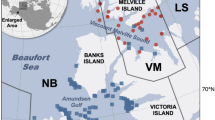Abstract.
We estimated both the numerical and biomass composition of the prey of polar bears (Ursus maritimus) from 135 opportunistic observations of kills in Svalbard and the western Barents Sea collected from March to October 1984–2001. By number, the prey composition was dominated by ringed seals (Phoca hispida) (63%), followed by bearded seals (Erignathus barbatus) (13%), harp seals (P. groenlandica) (8%) and unknown species (16%). However, when known prey were converted to biomass, the composition was dominated by bearded seals (55%), followed by ringed seals (30%) and harp seals (15%). Results indicated that bearded seals are an important dietary item for polar bears in the western Barents Sea. We believe that different patterns of space use by different bears may result in geographic variation of diet within the same population.
Similar content being viewed by others
Author information
Authors and Affiliations
Additional information
Electronic Publication
Rights and permissions
About this article
Cite this article
Derocher, A.E., Wiig, Ø. & Andersen, M. Diet composition of polar bears in Svalbard and the western Barents Sea. Polar Biol 25, 448–452 (2002). https://doi.org/10.1007/s00300-002-0364-0
Accepted:
Issue Date:
DOI: https://doi.org/10.1007/s00300-002-0364-0




